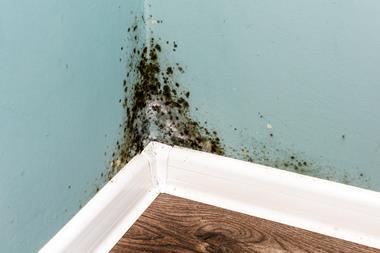Industry experts have noticed a worrying increase in claims farming from CMCs in the property disrepair arena
Property disrepair claims are swiftly becoming “the new PPI” as claims management companies (CMCs) move away from pushing whiplash-based claims and “plug in” to this new focus area.

When the Official Injury Claim (OIC) portal was launched by the Ministry of Justice and Motor Insurers’ Bureau in May 2021, the insurance industry hoped that the new system would help to reduce the amount of fraudulent whiplash claims - although this was not the explicit intent of the portal.
One year on and the amount of total whiplash claims have come down significantly, alongside a reduction in detected fraud.
Only around 1% of all represented claims on the OIC portal are being managed by CMCs, according to the latest batch of portal data published on 11 April 2022, which has been taken by the insurance sector as an indicator of a significant reduction in fraud.
Fraudulent actors have not simply disappeared, however. Attendees at May 2022’s Fraud Charter roundtable, hosted by Insurance Times and sponsored by Carpenters Group, explained that they had noticed a marked increase in the volume of potentially fraudulent property disrepair claims.
This followed the previous Fraud Charter event in March 2022, at which Laura Horrocks, head of fraud technology and intelligence for Sedgwick’s UK-based investigation services division, told attendees that CMCs were jumping into the property disrepair arena because these claims were profitable and difficult to challenge.
Last month’s roundtable confirmed this trend, with a range of attendees explaining that they too had noticed an acceleration in the growth of CMCs homing in on property disrepair claims.
Ruth Needham, partner at Keoghs, said: “It’s like the new payment protection insurance (PPI).
“If you check the websites of these small claimant firms, they are literally plugging into [the property disrepair market] and that tells you everything. It’s absolutely growing.”
Injuries that can be claimed for in relation to property disrepair – such as asthma caused by mould – are difficult to confirm as having been caused by the disrepair itself. This makes these claims particularly attractive to fraudsters, especially since claimants are able to recover legal costs - unlike whiplash claims under the new OIC system.
Perfect storm
Donna Scully, director at law firm Carpenters Group, added: “Because the new OIC portal is quite tricky to use, especially in the pro-user space, manually loading claims is not viable. So, I think [CMCs] are just thinking ‘we can’t make it work, so we’ll move into housing disrepair’.
“It’s definitely a very big problem and everybody needs to be aware of it.”
The implementation of the OIC portal is not the only contributory factor influencing the rise in property disrepair claims, however. Attending anti-fraud experts noted that prevailing poor economic conditions had created fertile ground which fraudulent CMCs could take advantage of.
Mark Allen, chief fraud and financial crime officer at trade body the ABI, said: “In every recession we’ve had since the 1980s, there has been an associated rise in insurance fraud and we do currently have a cost of living crisis.”
Scully agreed, noting that people struggling financially may be tempted by promises of easy money from CMCs for property disrepair claims.
“It really is the perfect storm,” she said. ”The cost of living crisis and insurance have to be looked at hand in hand. Whenever there’s a financial threat, there is going to be a knock-on effect for insurance.”
Particularly unfair
The methods of claims farming for property disrepair have included utilising all the traditional communication channels, with the addition of leaflet drops targeting housing estates and associations where there are particularly high rates of poverty.
Horrocks explained: “The thing that’s really unfair about the disrepair claims is that [CMCs] are targeting the lower income families with leaflet drops and they’re buying big address books of emails.”
She added that her husband had even received an email from a CMC, explaining how easy it was to set up a claim.
However, she clarified that it was not entirely in the claimant’s interest to enter into this type of arrangement.
“What the CMCs do on these leaflet drops is sign people up on [their doorsteps] and make it sound so easy to make a claim. But what they don’t say is that if the claimant then pulls out, they have to pay back £1,000 – which most people can’t afford to do – so they then have to pursue the claim.”
Leaflet drops have reportedly been focused on housing estates in London, particularly in the southern borough of Lambeth. One housing association told an attendee at the Fraud Charter that the levels of claims they were receiving for property disrepair was “escalating”.
At the previous Fraud Charter event in March, Needham noted that Lambeth council had seen a 600% rise in housing disrepair claims over the preceding 12-month period.
Horrocks added that some housing associations had admitted that property disrepair claims were “a bit of an open goal” because they were aware their properties were not necessarily up to standard - albeit not falling into the definition of disrepair appropriate for a claim either.
Once CMCs have identified an area for a leaflet drop and processed successful claims from it, some are even reportedly using data from previous claims to target additional potential claimants, Fraud Charter attendees said.
Know your enemy
Responding to the rise in potentially fraudulent property disrepair claims is only possible when there is industry consensus on how to approach the issue.
However, the Ministry of Justice’s deputy director for civil justice and law policy, David Parkin, said that although the government department was “always on the look out for how the justice system could be exploited for fraudulent purposes”, property disrepair was “not something that - as yet - is featuring in minister’s post bags”.
Fraud Charter attendees agreed that there had been no significant coverage of the growing issue of farmed property disrepair claims in the national press – meaning that it was vital for the insurance industry to be aware of this growing fraud threat.
Hosted by comedian and actor Tom Allen, 34 Gold, 23 Silver and 22 Bronze awards were handed out across an amazing 34 categories recognising brilliance and innovation right across the breadth of UK general insurance.



















































No comments yet